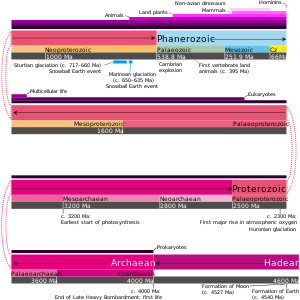While also using the international geologic time scale, many nations–especially those with isolated and therefore non-standard prehistories–use their own systems of dividing geologic time into epochs and faunal stages.

In New Zealand, these epochs and stages use local place names (mainly Māori in origin) back to the Permian. Prior to this time, names mostly align to those in the Australian geologic time scale, and are not divided into epochs.[1] In practice, these earlier terms are rarely used, as most New Zealand geology is of a more recent origin. In all cases, New Zealand uses the same periods as those used internationally; the renaming only applies to subdivisions of these periods. Very few epochs and stages cross international period boundaries, and the exceptions are almost all within the Cenozoic Era. New Zealand updates will always be behind any significant international updates in the International Geological Time Scale.
Although the New Zealand geologic time scale has not been formally adopted, it has been widely used by earth scientists, geologists and palaeontologists in New Zealand since J. S. Crampton proposed it in 1995. The most recent calibrated update was in 2015.[2] [3]
A standard abbreviation is used for these epochs and stages. These are usually in the form Xx, where the first letter is the initial letter of the epoch and the second (lower-case) letter is the initial letter of the stage. These are noted beside the stage names in the list below.
Currently, from the New Zealand perspective we are in the Haweran stage of the Wanganui epoch which is within the internationally defined Holocene epoch of the Quaternary period of the Cenozoic era. The Haweran, which started some 340,000 years ago, is named after the North Island town of Hāwera. The New Zealand stages and epochs are not the same as internationally defined periods and epochs (e.g. the Wanganui epoch started at 5.33 Ma which is within the Neogene period and matches the start of the international Pliocene epoch, but contains also the international Holocene and Pleistocene epochs).
- ^ Cooper, R. A. (2004). "The New Zealand geological timescale". Institute of Geological and. Nuclear Sciences Monograph. 22: 1–284.
- ^ Raine, JI; Beu, AG; Boyes, AF; Campbell, HJ; Cooper, RA; Crampton, JS; Crundwell, MP; Hollis, CJ; Morgans, HEG; Mortimer, N (2015). "New Zealand Geological Timescale NZGT 2015/1". New Zealand Journal of Geology and Geophysics. 58 (4): 398–403. doi:10.1080/00288306.2015.1086391. S2CID 131209497.
- ^ Raine, Ian (2015-03-20). "New Zealand geologic timescale poster 2015 (PDF format)" (PDF). Retrieved 2022-09-03.
